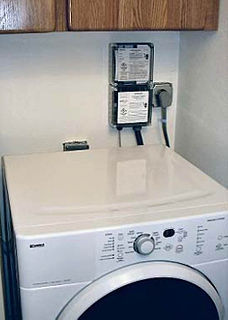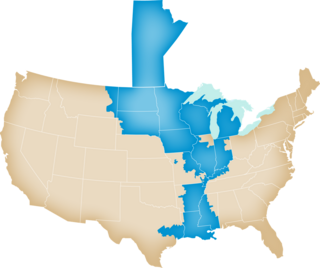
Electric power transmission is the bulk movement of electrical energy from a generating site, such as a power plant, to an electrical substation. The interconnected lines which facilitate this movement are known as a transmission network. This is distinct from the local wiring between high-voltage substations and customers, which is typically referred to as electric power distribution. The combined transmission and distribution network is part of electricity delivery, known as the "power grid" in North America, or just "the grid". In the United Kingdom, India, Tanzania, Myanmar, Malaysia and New Zealand, the network is known as the National Grid.

The Federal Energy Regulatory Commission (FERC) is the United States federal agency that regulates the transmission and wholesale sale of electricity and natural gas in interstate commerce and regulates the transportation of oil by pipeline in interstate commerce. FERC also reviews proposals to build interstate natural gas pipelines, natural gas storage projects, and liquefied natural gas (LNG) terminals, in addition to licensing non-federal hydropower projects.

The North American Electric Reliability Corporation (NERC) is a nonprofit corporation based in Atlanta, Georgia, and formed on March 28, 2006, as the successor to the North American Electric Reliability Council. The original NERC was formed on June 1, 1968, by the electric utility industry to promote the reliability and adequacy of bulk power transmission in the electric utility systems of North America. NERC's mission states that it is to "ensure the reliability of the North American bulk power system."
In economic terms, electricity is a commodity capable of being bought, sold, and traded. An electricity market is a system enabling purchases, through bids to buy; sales, through offers to sell; and short-term trading, generally in the form of financial or obligation swaps. Bids and offers use supply and demand principles to set the price. Long-term trades are contracts similar to power purchase agreements and generally considered private bi-lateral transactions between counterparties.

The electric power industry covers the generation, transmission, distribution and sale of electric power to the general public and industry. The commercial distribution of electric power started in 1882 when electricity was produced for electric lighting. In the 1880s and 1890s, growing economic and safety concerns lead to the regulation of the industry. What was once an expensive novelty limited to the most densely populated areas, reliable and economical electric power has become an essential aspect for normal operation of all elements of developed economies.

Manitoba Hydro is the electric power and natural gas utility in the province of Manitoba, Canada. Founded in 1961, it is a provincial Crown Corporation, governed by the Manitoba Hydro-Electric Board and the Manitoba Hydro Act. Today the company operates 15 interconnected generating stations. It has more than 527,000 electric power customers and more than 263,000 natural gas customers. Since most of the electrical energy is provided by hydroelectric power, the utility has low electricity rates. Stations in Northern Manitoba are connected by a HVDC system, the Nelson River Bipole, to customers in the south. The internal staff are members of the Canadian Union of Public Employees Local 998 while the outside workers are members of the International Brotherhood of Electrical Workers Local 2034.
The Open Access Same-Time Information System (OASIS), is an Internet-based system for obtaining services related to electric power transmission in North America. It is the primary means by which high-voltage transmission lines are reserved for moving wholesale quantities of electricity. The OASIS concept was originally conceived with the Energy Policy Act of 1992, and formalized in 1996 through Federal Energy Regulatory Commission (FERC) Orders 888 and 889.

The Public Utility Regulatory Policies Act is a United States Act passed as part of the National Energy Act. It was meant to promote energy conservation and promote greater use of domestic energy and renewable energy. The law was created in response to the 1973 energy crisis, and one year in advance of a second energy crisis.

The mission of the Western Area Power Administration (WAPA) is to market and deliver clean, renewable, reliable, cost-based federal hydroelectric power and related services. As one of the four power marketing administrations within the U.S. Department of Energy, WAPA's role is to market wholesale hydropower generated at 56 hydroelectric federal dams operated by the Bureau of Reclamation, United States Army Corps of Engineers and the International Boundary and Water Commission. WAPA delivers this power through a more than 17,000-circuit-mile, high-voltage power transmission system to more than 700 preference power customers across the West. Those customers, in turn, provide retail electric service to more than 40 million consumers. WAPA is headquartered in the Denver, Colorado suburb of Lakewood, Colorado.
The Chelan County Public Utility District, or Chelan County PUD, provides electric, water, wastewater public utility and telecommunications services in Chelan County, in north-central Washington, USA.

A regional transmission organization (RTO) in the United States is an electric power transmission system operator (TSO) that coordinates, controls, and monitors a multi-state electric grid. The transfer of electricity between states is considered interstate commerce, and electric grids spanning multiple states are therefore regulated by the Federal Energy Regulatory Commission (FERC). The voluntary creation of RTOs was initiated by FERC Order No. 2000, issued on December 20, 1999. The purpose of the RTO is to promote economic efficiency, reliability, and non-discriminatory practices while reducing government oversight.

Demand response is a change in the power consumption of an electric utility customer to better match the demand for power with the supply. Until recently electric energy could not be easily stored, so utilities have traditionally matched demand and supply by throttling the production rate of their power plants, taking generating units on or off line, or importing power from other utilities. There are limits to what can be achieved on the supply side, because some generating units can take a long time to come up to full power, some units may be very expensive to operate, and demand can at times be greater than the capacity of all the available power plants put together. Demand response seeks to adjust the demand for power instead of adjusting the supply.

The Southwest Power Pool (SPP) is the founding member of the North American Electric Reliability Corporation (NERC). Its headquarters are in Little Rock, Arkansas. The market lies on the western most edge of the Eastern Interconnection. Most of its wind generation lies on the western edge of the footprint, while most of the major load centers lie on the eastern edge, creating a dynamic wherein power frequently flows west to east. Furthermore, its vast latitude enables wide temperature gradients and often contributes to significant north to south or south to north flows, depending on the season.
A NERC Tag, also commonly referred to as an E-Tag, represents a transaction on the North American bulk electricity market scheduled to flow within, between or across electric utility company territories. The NERC Tag is named for the North American Electric Reliability Corporation (NERC), which is the entity that was responsible for the implementation of the first energy tagging processes. NERC Tags were first introduced in 1997, in response to the need to track the increasingly complicated energy transactions which were produced as a result of the beginning of electric deregulation in North America.

The Midcontinent Independent System Operator, Inc., formerly named Midwest Independent Transmission System Operator, Inc. (MISO) is an Independent System Operator (ISO) and Regional Transmission Organization (RTO) providing open-access transmission service and monitoring the high-voltage transmission system in the Midwest United States and Manitoba, Canada and a southern United States region which includes much of Arkansas, Mississippi, and Louisiana. MISO also operates one of the world's largest real-time energy markets.
Electrical power system simulation involves power system modeling and network simulation in order to analyze electrical power systems using design/offline or real-time data. Power system simulation software's are a class of computer simulation programs that focus on the operation of electrical power systems. These types of computer programs are used in a wide range of planning and operational situations for:
- Electric power generation - Nuclear, Conventional, Renewable
- Commercial facilities
- Utility transmission
- Utility distribution
- Railway power systems
- Industrial power systems

ITC Transmission was founded in 1999 as International Transmission Co., a subsidiary of Detroit Edison, charged in the ownership, operation and maintenance of Detroit Edison's transmission system. In 2003, DTE sold the subsidiary to ITC Holdings Corp. In 2004, ITC Transmission became the first, fully independent electricity transmission company in the United States following the 2003 transfer of ownership from DTE Energy to ITC Transmission’s parent company, ITC Holdings Corp. ITC Transmission owns a fully regulated, high-voltage system that transmits electricity to local electricity distribution facilities. ITC Holdings Corp. became a publicly traded company in 2005 and is headquartered in Novi, Michigan. Today it owns transmission systems in several states under a unique independent business model.

ISO New England Inc. (ISO-NE) is an independent, non-profit Regional Transmission Organization (RTO), headquartered in Holyoke, Massachusetts, serving Connecticut, Maine, Massachusetts, New Hampshire, Rhode Island, and Vermont.

PJM Interconnection LLC (PJM) is a regional transmission organization (RTO) in the United States. It is part of the Eastern Interconnection grid operating an electric transmission system serving all or parts of Delaware, Illinois, Indiana, Kentucky, Maryland, Michigan, New Jersey, North Carolina, Ohio, Pennsylvania, Tennessee, Virginia, West Virginia, and the District of Columbia.

An electrical grid, electric grid or power grid, is an interconnected network for delivering electricity from producers to consumers. It consists of:












